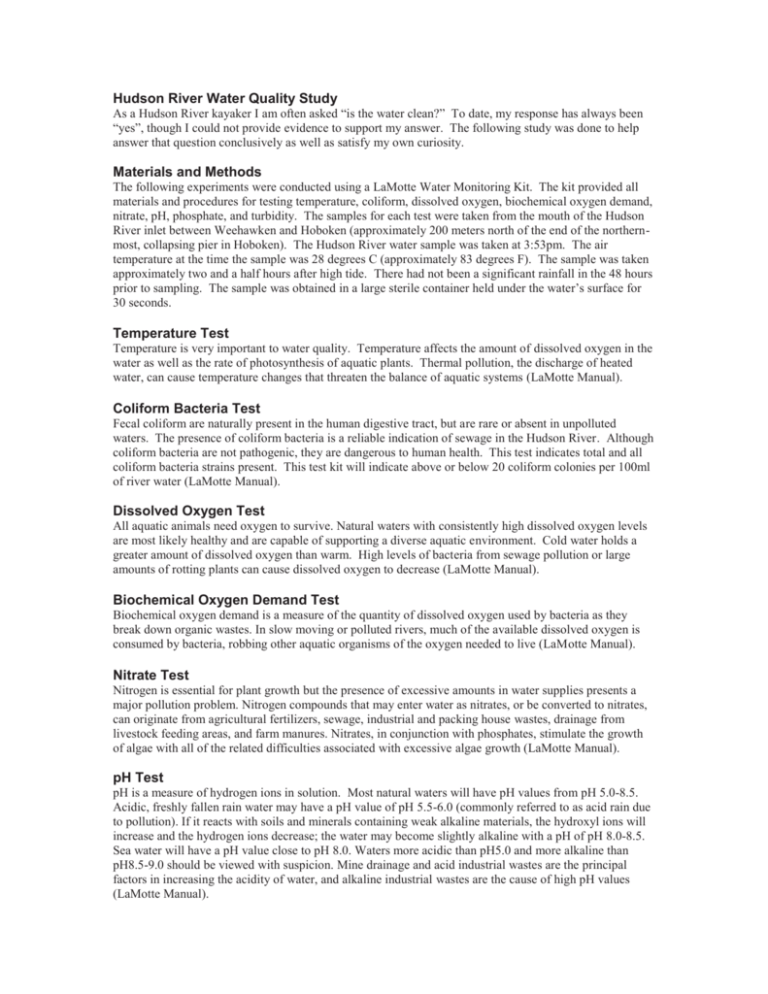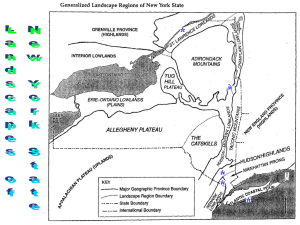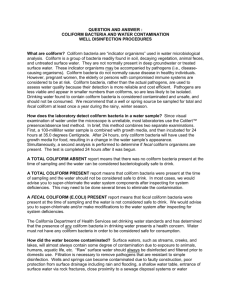Water Quality Testing Information
advertisement

Hudson River Water Quality Study As a Hudson River kayaker I am often asked “is the water clean?” To date, my response has always been “yes”, though I could not provide evidence to support my answer. The following study was done to help answer that question conclusively as well as satisfy my own curiosity. Materials and Methods The following experiments were conducted using a LaMotte Water Monitoring Kit. The kit provided all materials and procedures for testing temperature, coliform, dissolved oxygen, biochemical oxygen demand, nitrate, pH, phosphate, and turbidity. The samples for each test were taken from the mouth of the Hudson River inlet between Weehawken and Hoboken (approximately 200 meters north of the end of the northernmost, collapsing pier in Hoboken). The Hudson River water sample was taken at 3:53pm. The air temperature at the time the sample was 28 degrees C (approximately 83 degrees F). The sample was taken approximately two and a half hours after high tide. There had not been a significant rainfall in the 48 hours prior to sampling. The sample was obtained in a large sterile container held under the water’s surface for 30 seconds. Temperature Test Temperature is very important to water quality. Temperature affects the amount of dissolved oxygen in the water as well as the rate of photosynthesis of aquatic plants. Thermal pollution, the discharge of heated water, can cause temperature changes that threaten the balance of aquatic systems (LaMotte Manual). Coliform Bacteria Test Fecal coliform are naturally present in the human digestive tract, but are rare or absent in unpolluted waters. The presence of coliform bacteria is a reliable indication of sewage in the Hudson River. Although coliform bacteria are not pathogenic, they are dangerous to human health. This test indicates total and all coliform bacteria strains present. This test kit will indicate above or below 20 coliform colonies per 100ml of river water (LaMotte Manual). Dissolved Oxygen Test All aquatic animals need oxygen to survive. Natural waters with consistently high dissolved oxygen levels are most likely healthy and are capable of supporting a diverse aquatic environment. Cold water holds a greater amount of dissolved oxygen than warm. High levels of bacteria from sewage pollution or large amounts of rotting plants can cause dissolved oxygen to decrease (LaMotte Manual). Biochemical Oxygen Demand Test Biochemical oxygen demand is a measure of the quantity of dissolved oxygen used by bacteria as they break down organic wastes. In slow moving or polluted rivers, much of the available dissolved oxygen is consumed by bacteria, robbing other aquatic organisms of the oxygen needed to live (LaMotte Manual). Nitrate Test Nitrogen is essential for plant growth but the presence of excessive amounts in water supplies presents a major pollution problem. Nitrogen compounds that may enter water as nitrates, or be converted to nitrates, can originate from agricultural fertilizers, sewage, industrial and packing house wastes, drainage from livestock feeding areas, and farm manures. Nitrates, in conjunction with phosphates, stimulate the growth of algae with all of the related difficulties associated with excessive algae growth (LaMotte Manual). pH Test pH is a measure of hydrogen ions in solution. Most natural waters will have pH values from pH 5.0-8.5. Acidic, freshly fallen rain water may have a pH value of pH 5.5-6.0 (commonly referred to as acid rain due to pollution). If it reacts with soils and minerals containing weak alkaline materials, the hydroxyl ions will increase and the hydrogen ions decrease; the water may become slightly alkaline with a pH of pH 8.0-8.5. Sea water will have a pH value close to pH 8.0. Waters more acidic than pH5.0 and more alkaline than pH8.5-9.0 should be viewed with suspicion. Mine drainage and acid industrial wastes are the principal factors in increasing the acidity of water, and alkaline industrial wastes are the cause of high pH values (LaMotte Manual). Phosphate Test Phosphorus is an important nutrient for aquatic plants and is fundamental in metabolic reactions. The amount found in water is generally not more than 0.1 ppm unless the water has become polluted from waste water sources or excessive drainage from agricultural areas. When phosphorus is present in excess of the concentrations required for normal aquatic plant growth, a process called eutrophication takes place. This creates a favorable environment for the increase in algae and weed nuisances that produce scums and odors. When algae cells die, oxygen is used in the decomposition and fish kills often result. Rapid decomposition of dense algae scums with associated organisms give rise to foul odors and hydrogen sulfide gas. Inorganic phosphate, which is largely the form of phosphorus required for plant growth, is determined by its reaction with a molybdate solution to form a phosphomolybdate which, when reduced, forms a blue color which is the basis for a very sensitive test for phosphorus. The production of more than a faint blue color in this test is cause for suspicion of phosphate pollution (LaMotte Manual). Turbidity Test Turbidity is the measure of the relative clarity of water. Turbid water is the result of suspended matter such as clay, silt, and organic matter. Turbidity should not be confused with color since darkly colored water can still be clear and not turbid. Turbid water may be the result of soil erosion, urban runoff, algal blooms, and, in the case of the Hudson River, bottom sediment disturbances (LaMotte Manual). Results 1. 2. 3. 4. 5. 6. 7. 8. Water temperature – 27 degrees C (approximately 80 degrees F) Coliform bacteria – positive, above 20 coliform bacteria colonies per 100ml of water. Dissolved oxygen – 8ppm at 27 degrees C equals a dissolved oxygen rate of over 99% Biochemical dissolved oxygen – tests pending Nitrate – 5ppm Phosphate - >1ppm pH – 7 Turbidity- dark disk visible, 0 to 40 JTU Analysis Water temperature – the above average temperatures air temperatures of the Hudson River Watershed are effecting the water temperatures slightly. The Hudson River temperature is slightly above average for this time of year. Coliform bacteria- The study’s confirmation of fecal coliform colony counts higher than 20 per 100ml of Hudson River Water is the most concerning. The study cannot conclude the cause of the fecal coliform levels, but raw sewage contamination should not be ruled out. Rank - Poor Dissolved oxygen- A high level of dissolved oxygen is a positive indicator for a healthy watershed. A result over 99% is a very positive sign for the Hudson River. Rank – Excellent Biochemical dissolved oxygen- Test still pending Nitrate- a low result for nitrates is a positive sign for a watershed. This study’s result of 5ppm is a moderate result for the Hudson River. Rank - Fair Phosphate- like nitrates, a low result for phosphates is necessary for a healthy watershed. >1ppm is an excellent result for the Hudson River. Rank – Excellent pH- There are many more accurate ways of measuring pH than what was utilized in this study. The brackish water of the Hudson River tested slightly alkaline, but well within norms. Rank – Good to Excellent Turbidity- a lower turbidity equals a higher clarity of water. Rank – Good to Excellent Application The test results conclude that there are many positive signs for the Hudson River. The Hudson River ranks fair to excellent in all tests, except one, that help indicate a healthy river. The fecal coliform test is cause for concern. All tests should be duplicated. Further testing for coliform will be necessary. Discussion The clean up the Hudson River has been underway for many decades. Many people, however, remain skeptical that the Hudson River is clean enough for recreation activities such as swimming, boating, and fishing. At one point, the Hudson River was one of the most polluted waterways in the world. This is no longer true. As this study proves, there are many positives signs of the health of the Hudson. I was pleasantly surprised by the number of “excellent” results this study obtained. Though there is much work to do (I was not surprised by the poor coliform result), I hope this study gives people the confidence to enjoy our river more - to get into that sailboat or kayak, or enter the NYC triathlon. The more people use the Hudson, the more they will take an interest in caring for it. .








